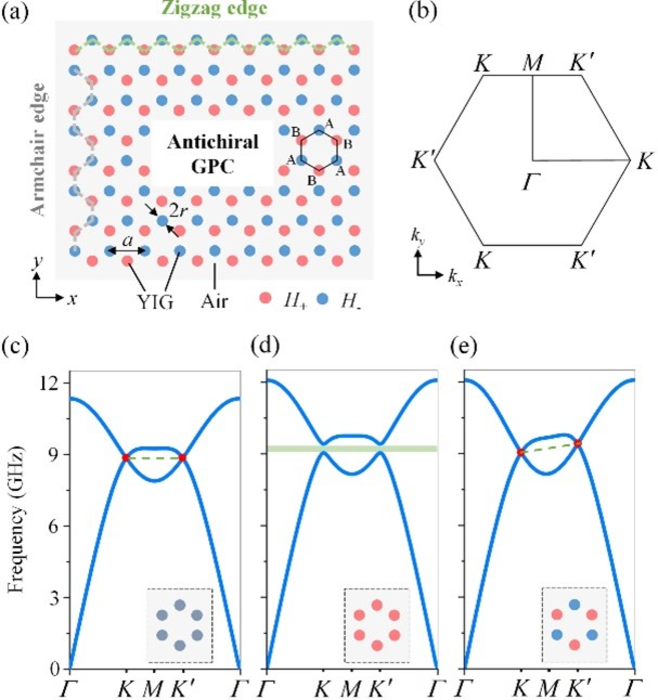A recent publication from Opto-Electronic Science illustrates customizable topological beam splitting through antichiral gyromagnetic photonic crystal.
 Construction of antichiral gyromagnetic photonic crystal. (a) Schematic illustration of antichiral gyromagnetic photonic crystal. (b) The first Brillouin zone of the honeycomb lattice. (c) Nonmagnetized gyromagnetic photonic crystal. (d) Uniformly magnetized gyromagnetic photonic crystal. (e) Compound magnetized gyromagnetic photonic crystal. Image Credit: OEA
Construction of antichiral gyromagnetic photonic crystal. (a) Schematic illustration of antichiral gyromagnetic photonic crystal. (b) The first Brillouin zone of the honeycomb lattice. (c) Nonmagnetized gyromagnetic photonic crystal. (d) Uniformly magnetized gyromagnetic photonic crystal. (e) Compound magnetized gyromagnetic photonic crystal. Image Credit: OEA
Topological insulators, whose bulky states are prohibited while surface/edge states are topologically protected and conductive. The latest progress in topologically protected edge states has garnered a lot of attention in the photonics and optics community.
In 2008, Haldane and Raghu first speculated in theory that topologically protected chiral one-way edge state can be formed by analogy to the integer quantum Hall effect in a two-dimensional (2D) electron gas system, where the one-way edge states spread along the opposite directions at two parallel edges of a gyromagnetic photonic crystal [Phys. Rev. Lett. 100, 013904 (2008)].
In 2020, the research team of Prof. Zhi-Yuan Li from the South China University of Technology hypothetically suggested another fascinating case where the one-way edge states at two opposite parallel zigzag edges can spread in the same direction, and they are referred to as antichiral one-way edge states [Phys. Rev. B 101, 214102 (2020)].
Up to now, antichiral one-way edge states have been explored in various bosonic and fermionic platforms, but a number of studies only concentrated on the illustration of antichiral one-way transport property, and only a few of them explored the novel properties of antichiral topological platforms and unique applications.
This article covers the creation and observation of topological beam splitting with the effortlessly modifiable right-to-left ratio in an antichiral gyromagnetic photonic crystal. The splitter is configurable and compact, has high transmission efficacy, is crosstalk-proof, allows for multi-channel utilization, and is strong against flaws and hindrances.
This performance is credited to the strange feature in that antichiral one-way edge states can exist only at the zigzag edge and not at the armchair edge of the antichiral gyromagnetic photonic crystal.
When two rectangular antichiral gyromagnetic photonic crystals that hold left- and right-propagating antichiral one-way edge states, respectively, are integrated, bidirectionally radiating one-way edge states can be accomplished at two parallel zigzag edges.
Finally, they engineered a topological beam splitting with the configurable splitting ratio that can easily be altered just by modifying the source excitation condition. These observations can enhance current understandings of fundamental physics and advance topological photonic applications.
Journal Reference:
Chen, J. F., et al. (2022) Configurable topological beam splitting via antichiral gyromagnetic photonic crystal. Opto-Electronic Science. doi.org/10.29026/oes.2022.220001.